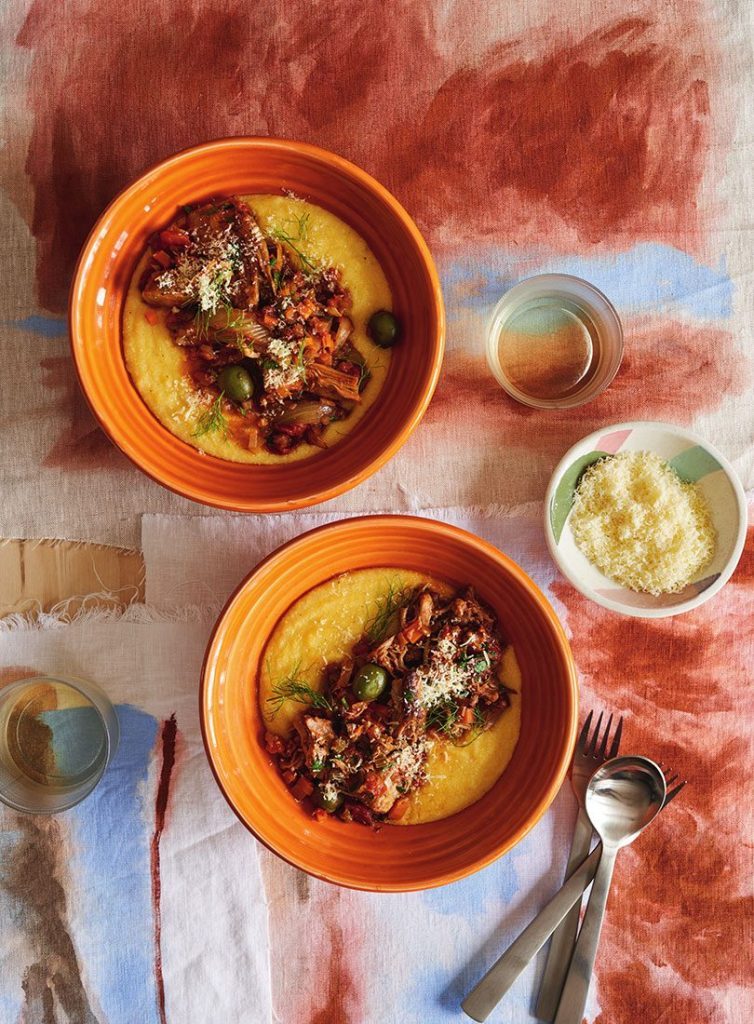SLOW-COOKED PORK RAGÙ / ARTICHOKE & FENNEL RAGÙ FOR PAPPARDELLE OR POLENTA
Ginny Grant

Serves
6 for the Pork Ragu, 4 for the Artichoke & Fennel RaguPreparation
15 minsCook
2½ hrs for the Pork Ragu, 50 mins for the Artichoke & Fennel RaguIngredients
| FOR BOTH VERSIONS | |
| 2 tablespoons olive oil | |
| 2 onions, chopped | |
| 4 medium carrots, peeled, chopped | |
| 2 stalks celery | |
| 4 cloves garlic, chopped | |
| 2 teaspoons fennel seeds | |
| 250ml dry white wine | |
| ¼ cup capers | |
| 150g green olives | |
| 2 x 400g cans chopped tomatoes | |
| ½ cup flat-leafed parsley, chopped | |
| FOR THE PORK RAGÙ | |
| 1 pork shoulder, approx 1.2-1.4kg, skin removed (make into crackling if you wish, to garnish on top) | |
| 3 anchovies | |
| FOR THE ARTICHOKE & FENNEL RAGÙ | |
| 1 large fennel bulb, cut into thin wedges | |
| 1 x 400g jar artichokes, drained and rinsed (or use canned jackfruit or banana blossoms instead) | |
| FOR THE POLENTA | |
| 1.2 litres vegetable stock | |
| 1 teaspoon salt | |
| 200g instant polenta | |
| 50g butter | |
| 50g vegetarian-rennet parmesan, freshly grated (I often use Mahoe Very Old Edam instead) |
Pork shoulder is a much-underrated cut, which is surprising given the collective love of pulled pork. I don’t eat a lot of pork, so when I do I want it to be ethically sourced as well as great eating. At Mangarara Station in Hawke’s Bay, Berkshire pigs (as well as beef) are raised on a regenerative farm, and that is what I used here. Other great producers of excellent quality pork include Farm Gate Produce, Havoc Farms and Poaka.
Rich and cheesy polenta is what I’ve served here (although you could serve it with pappardelle). It’s important to use a great cheese: I’ve found that most supermarket vegetarian-rennet parmesans are pretty woeful, but on the plus side there are many great local hard cheeses that you can use in their place. Should you be lucky enough to score some Craggy Range Sheep Dairy Pecorino, it’s well worth buying; as is Mahoe Very Old Edam (which is what I have used here; all Mahoe Cheese cheeses are made with vegetarian rennet).
Instructions
| 1. | PORK RAGÙ |
| 2. | Heat the oven to 160°C. |
| 3. | Heat 1 tablespoon oil in a pan, season the pork with salt and brown all over. |
| 4. | Remove from the pan and set aside. |
| 5. | Put half the onion, carrot and celery into the pan and fry gently until softened. |
| 6. | Add the anchovies and half the garlic and fennel seeds, and cook until fragrant and the anchovies have melted. |
| 7. | Add the pork back to the pan and add ½ cup wine and reduce by half, then add half the capers and olives, 1 can of tomatoes and 1 cup water. |
| 8. | Bring up to a simmer, cover and put into the oven for 2 hours or until the meat is very tender and shreds easily with a fork, adding a little extra water if the pan is drying out. |
| 9. | Cool for a few minutes before shredding into pieces with a couple of forks. |
| 10. | ARTICHOKE AND FENNEL RAGÙ |
| 11. | Heat the remaining oil in a separate pan and fry the fennel bulb gently until nicely caramelised. |
| 12. | Add the remaining onion, carrot and celery and fry until soft, then add the remaining garlic and fennel seeds and fry until fragrant. |
| 13. | Add the artichokes and the remaining white wine and reduce by half. |
| 14. | Add the remaining capers, olives and can of tomatoes and 1 cup of water. |
| 15. | Simmer gently for 30-40 minutes, adding a little water to loosen the mix if needed. |
| 16. | FOR BOTH DISHES |
| 17. | Check the seasoning and divide the parsley between the two. |
| 18. | POLENTA |
| 19. | Bring the stock to the boil in a medium saucepan then add the salt. |
| 20. | Make a whirlpool in the water with a whisk. |
| 21. | Use a jug to pour in the polenta in a thick stream, then bring back to the boil, whisking constantly to ensure there are no lumps. |
| 22. | Cook for another 10 minutes, whisking regularly, until the polenta comes away from the sides of the pan and has a smooth texture. |
| 23. | Add the butter and parmesan and adjust the seasoning to taste. |
| 24. | If you aren’t serving it straight away, pour into a stainless bowl, dot with butter (which helps prevent a skin from forming), cover with baking paper and foil and keep warm over a water bath. Stir well before using. |
Recipes & food styling Ginny Grant / Photography Aaron McLean / Styling Jessica Hemmings

Leave a Reply